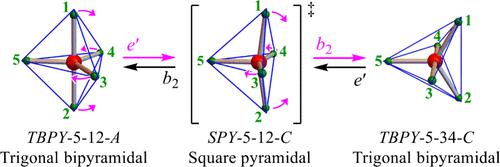“Polytopal Rearrangement Model of Stereoisomerization” and Its Potential as the Basis for a Systematic Model of All Stereoisomerism
IF 3.3
Q2 CHEMISTRY, MULTIDISCIPLINARY
引用次数: 0
Abstract
The term “polytopal rearrangement” describes any shape changing process operating on a coordination “polyhedron”─the solid figure defined by the positions of the ligand atoms directly attached to the central atom of a coordination entity. Developed in the latter third of the last century, the polytopal rearrangement model of stereoisomerization is a general mathematical approach for analyzing and accommodating the complexity of such processes for any coordination number. The motivation for the model was principally to deal with the complexity, such as Berry pseudorotation in pentavalent phosphorus species, arising from rearrangements in inorganic coordination complexes of higher coordination numbers. The model is also applicable to lower coordination centers, for example, thermal “inversion” at nitrogen in NH3 and amines. We present the history of the model focusing on its essential features, and review some of the more subtle aspects addressed in recent literature. We then introduce a more detailed and rigorous modern approach for describing such processes using an assembly of existing concepts, with the addition of formally described terminology and representations. In our outlook, we contend that the rigorous and exhaustive application of the principles of the polytopal rearrangement model, when combined with torsional isomerism, will provide a basis for a mathematically complete, general, and systematic classification for all stereoisomerism and stereoisomerization. This is essential for comprehensively mapping chemical structure and reaction spaces.

"立体异构的多醛重排模型 "及其作为所有立体异构系统模型基础的潜力
术语 "多面体重排 "描述了在配位 "多面体 "上发生的任何形状变化过程--"多面体 "是由直接连接到配位实体中心原子的配位原子的位置所定义的实体图形。立体异构化的多面体重排模型开发于上世纪后三叶,是一种通用的数学方法,用于分析和适应任何配位数的此类过程的复杂性。建立该模型的动机主要是为了处理较高配位数的无机配位复合物重排过程中产生的复杂性,如五价磷物种中的贝里假otation。该模型也适用于较低的配位中心,例如 NH3 和胺中氮的热 "反转"。我们介绍了该模型的历史,重点是其基本特征,并回顾了近期文献中涉及的一些更微妙的方面。然后,我们将介绍一种更详细、更严谨的现代方法,利用现有概念的组合,并添加正式描述的术语和表述,来描述此类过程。展望未来,我们认为,严格而详尽地应用多聚物重排模型的原理,并与扭转异构相结合,将为所有立体异构和立体异构化提供一个数学上完整、通用和系统的分类基础。这对于全面绘制化学结构和反应空间图至关重要。
本文章由计算机程序翻译,如有差异,请以英文原文为准。
求助全文
约1分钟内获得全文
求助全文
来源期刊

ACS Organic & Inorganic Au
有机化学、无机化学-
CiteScore
4.10
自引率
0.00%
发文量
0
期刊介绍:
ACS Organic & Inorganic Au is an open access journal that publishes original experimental and theoretical/computational studies on organic organometallic inorganic crystal growth and engineering and organic process chemistry. Short letters comprehensive articles reviews and perspectives are welcome on topics that include:Organic chemistry Organometallic chemistry Inorganic Chemistry and Organic Process Chemistry.
 求助内容:
求助内容: 应助结果提醒方式:
应助结果提醒方式:


